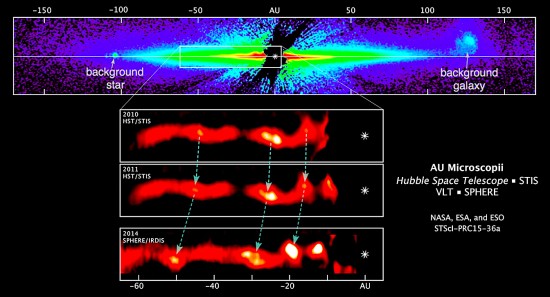
Hubble Space Telescope view of AU Microscopii combined with ESO SPHERE and the Very Large Telescope observations. Credit: NASA/ESA/ESO/G. Schneider (Steward Observatory), the HST GO 12228 team and A. Boccaletti (Paris Observatory).
Oct 9, 2015
Electric stars in an electric Universe.
The Nebular Hypothesis is considered the sine qua non of consensus star-forming theory. When a star condenses out of primordial material, it is thought that the remaining clumps of dust and gas that are not absorbed swirl around, attracting more stray bits, until they also condense, but this time into planets. This is how, it is believed, the Solar System was created billions of years ago. The disk of debris surrounding new stars is called an “accretion disk”. AU Microscopii is also surrounded by such a disk.
Star-forming regions are conventionally associated with high frequency light from their active regions. Gamma rays, X-rays, and extreme ultraviolet shine from the “cosmic eggs”, and appear to be the glowing tips of condensed gas balls. One example of these formations is in the Eagle Nebula, although the vast majority are located in the Orion Molecular Cloud and the Carina Nebula.
Recently, astronomers from the Max Planck Institute announced the discovery of fast-moving structures in the debris disk surrounding AU Microscopii. One of the more interesting aspects is that waves of influence are passing through the disk—so fast that the movement can be seen in telescopes.
According to the press release, “AU Mic is very active, and frequently produces sizable flares: Eruptions involving the star’s magnetic field, which catapult stellar plasma at high speed into the star’s surroundings. It is possible that the moving features in the dust disk are caused by such stellar activity.”
In an Electric Universe, the electromagnetic field of a star is what drives all activity. Incoming electric charge is focused by Bennett pinches into highly energetic plasmoids. More incoming electric current means more stellar output, especially at higher wavelengths.
Another important factor is that stellar disks are not due to gravitational accretion, they are due to electromagnetic expulsion. Dust and gas should be found around other stars if the Electric Star theory is correct. Stars “give birth” from their electrically charged interiors. There is no intensely hot core, radiating energy from thousands of kilometers deep inside. Instead, heavy elements are synthesized externally though plasma discharges and then “precipitate” into the star’s interior like a rain of metal atoms.
Therefore, many stars display transverse, donut-shaped twisted rings. Birkeland currents confine clouds of plasma within electromagnetic fields, causing toroidal concentrations. Toroidal filaments couple to hourglass-shaped current sheets that are subject to diocotron instabilities: the current flow through plasma sometimes forms vortices that change into distorted curlicue shapes. This phenomenon has been witnessed in many laboratory experiments.
In a previous Picture of the Day, it was reported that the reason some rings flatten and curl at the edges is because of plasma instabilities in the torus. As electric current density increases:
“The edges curl in and out and upwards and downwards to the current flow.” Anthony L. Peratt, Characteristics for the Occurrence of a High-Current, Z-Pinch Aurora as Recorded in Antiquity.
Electric Star theory resolves many of the distorted opinions that arise from misunderstanding the role of plasma and electric fields in space. Rather than kinetic activity, the radiant emanations from AU Microscopii are due to electric currents.
Stephen Smith












